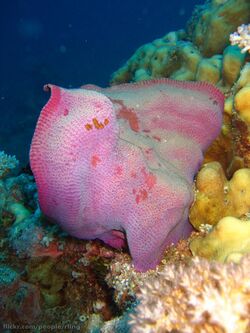Biology:Ianthella basta
| Ianthella basta | |
|---|---|

| |
| Elephant ear sponge | |
| Scientific classification | |
| Domain: | Eukaryota |
| Kingdom: | Animalia |
| Phylum: | Porifera |
| Class: | Demospongiae |
| Order: | Verongiida |
| Family: | Ianthellidae |
| Genus: | Ianthella |
| Species: | I. basta
|
| Binomial name | |
| Ianthella basta (Pallas, 1766)
| |
| Synonyms[1] | |
|
List
| |
Ianthella basta is a species of fan-shaped sea sponge in the class Demospongiae.[1] It is also known as the elephant ear sponge,[2] paper sponge, or scroll sponge.[3]
A sponge measuring 1.7 m in height and 9.5 m circumference has been estimated to be about 8 years old.[2]
Distribution
The elephant ear sponge is found in the Indo-Pacific region.[4][3] It is found on coral reefs in areas with rapid water flows.[3]
Ianthella basta are introduced species they do not tend to invade other species territories and are noncompetitive. [5]
Ecology
The sea cucumber (Synaptula lamperti) is closely associated with the sponge and makes use of certain nutrients exuded by it.[6]
Research is being undertaken on various metabolites and other biologically active constituents that are synthesized by the sponge.[7][8]
References
- ↑ 1.0 1.1 "Ianthella basta (Pallas, 1766)". World Porifera database. World Register of Marine Species. 2022. http://www.marinespecies.org/aphia.php?p=taxdetails&id=165135.
- ↑ 2.0 2.1 Rohde, Sven; Schupp, Peter J. (2011). "Growth and regeneration of the elephant ear sponge Ianthella basta (Porifera)". Ancient Animals, New Challenges. pp. 219–226. doi:10.1007/978-94-007-4688-6_18. ISBN 978-94-007-4687-9.
- ↑ 3.0 3.1 3.2 Saltcorner
- ↑ "Ianthella basta (Pallas, 1766)". Species. GBIF. http://www.gbif.org/species/2239348.
- ↑ Rohde, Sven; Schupp, Peter J. (2012-05-01). "Growth and regeneration of the elephant ear sponge Ianthella basta (Porifera)" (in en). Hydrobiologia 687 (1): 219–226. doi:10.1007/s10750-011-0774-5. ISSN 1573-5117. https://doi.org/10.1007/s10750-011-0774-5.
- ↑ Hammond, L.S.; Wilkinson, Clive R. (1985). "Exploitation of sponge exudates by coral reef holothuroids". Journal of Experimental Marine Biology and Ecology 94 (1–3): 1–9. doi:10.1016/0022-0981(85)90046-2.
- ↑ Kazlauskas, R.; Lidgard, R.O.; Murphy, P.T.; Wells, R.J. (1980). "Brominated tyrosine-derived metabolites from the sponge Ianthella basta". Tetrahedron Letters 21 (23): 2277–2280. doi:10.1016/0040-4039(80)80023-2.
- ↑ Pettit, George R.; Butler, Mark S.; Williams, Michael D.; Filiatrault, Melanie J.; Pettit, Robin K. (1996). "Isolation and structure of hemibastadinols 1−3 from the Papua New Guinea marine sponge Ianthella basta". Journal of Natural Products 59 (10): 927–934. doi:10.1021/np960249n. PMID 8904842.
Wikidata ☰ Q2235845 entry
 |

